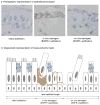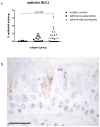The relationship between eosinophilia and airway remodelling in mild asthma
- PMID: 24261944
- PMCID: PMC4040270
- DOI: 10.1111/cea.12156
The relationship between eosinophilia and airway remodelling in mild asthma
Abstract
Background: Eosinophilia is a marker of corticosteroid responsiveness and risk of exacerbation in asthma; although it has been linked to submucosal matrix deposition, its relationship with other features of airway remodelling is less clear.
Objective: The aim of this study was to investigate the relationship between airway eosinophilia and airway remodelling.
Methods: Bronchial biopsies from subjects (n = 20 in each group) with mild steroid-naïve asthma, with either low (0-0.45 mm(-2)) ) or high submucosal eosinophil (23.43-46.28 mm(-2) ) counts and healthy controls were assessed for in vivo epithelial damage (using epidermal growth factor receptor staining), mucin expression, airway smooth muscle (ASM) hypertrophy and inflammatory cells within ASM.
Results: The proportion of in vivo damaged epithelium was significantly greater (P = 0.02) in the high-eosinophil (27.37%) than the low-eosinophil (4.14%) group. Mucin expression and goblet cell numbers were similar in the two eosinophil groups; however, MUC-2 expression was increased (P = 0.002) in the high-eosinophil group compared with controls. The proportion of submucosa occupied by ASM was higher in both asthma groups (P = 0.021 and P = 0.046) compared with controls. In the ASM, eosinophil and T-lymphocyte numbers were higher (P < 0.05) in the high-eosinophil group than both the low-eosinophil group and the controls, whereas the numbers of mast cells were increased in the high-eosinophil group (P = 0.01) compared with controls.
Conclusion: Submucosal eosinophilia is a marker (and possibly a cause) of epithelial damage and is related to infiltration of ASM with eosinophils and T lymphocytes, but is unrelated to mucus metaplasia or smooth muscle hypertrophy.
Keywords: asthma; eosinophil; epithelium; goblet cell; inflammation; remodelling; smooth muscle.
© 2013 John Wiley & Sons Ltd.
Conflict of interest statement
Declaration of all sources of funding:
Dr Wilson: a research grant for this study from GlaxoSmithKline
Dr Laviolette: participation in clinical trials on asthma treatment for GlaxoSmithKline, AstraZeneca, Boston Scientific and Johnson & Johnson and a research grant for this study from GlaxoSmithKline.
Dr Jarjour: a research grant for this study from GlaxoSmithKline
Professor Djukanovic: a research grant for this study from GlaxoSmithKline.
Figures







References
-
- Holgate ST, Davies DE, Lackie PM, Wilson SJ, Puddicombe SM, Lordan JL. Epithelial-mesenchymal interactions in the pathogenesis of asthma. J Allergy Clin Immunol. 2000;105:193–204. - PubMed
-
- Fahy JV. Goblet cell and mucin gene abnormalities in asthma. Chest. 2002;122:320S–326S. - PubMed
-
- Rogers DF. Airway mucus hypersecretion in asthma: an undervalued pathology? Curr Opin Pharmacol. 2004;4:241–250. - PubMed
Publication types
MeSH terms
Substances
Grants and funding
LinkOut - more resources
Full Text Sources
Other Literature Sources
Medical
Research Materials
Miscellaneous

